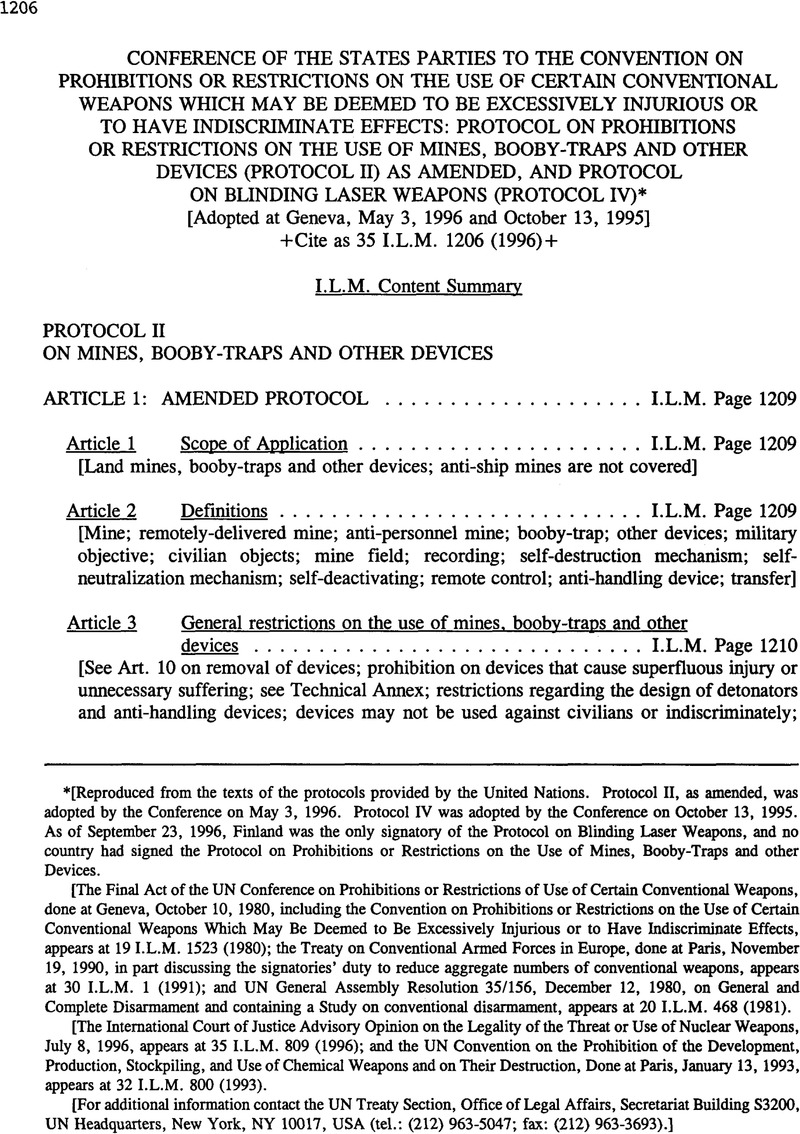Published online by Cambridge University Press: 18 May 2017

[Reproduced from the texts of the protocols provided by the United Nations. Protocol II, as amended, was adopted by the Conference on May 3, 1996. Protocol IV was adopted by the Conference on October 13, 1995. As of September 23, 1996, Finland was the only signatory of the Protocol on Blinding Laser Weapons, and no country had signed the Protocol on Prohibitions or Restrictions on the Use of Mines, Booby-Traps and other Devices.
[The Final Act of the UN Conference on Prohibitions or Restrictions of Use of Certain Conventional Weapons, done at Geneva, October 10, 1980, including the Convention on Prohibitions or Restrictions on the Use of Certain Conventional Weapons Which May Be Deemed to Be Excessively Injurious or to Have Indiscriminate Effects, appears at 19 I.L.M. 1523 (1980); the Treaty on Conventional Armed Forces in Europe, done at Paris, November 19, 1990, in part discussing the signatories’ duty to reduce aggregate numbers of conventional weapons, appears at 30 I.L.M. 1 (1991); and UN General Assembly Resolution 35/156, December 12, 1980, on General and Complete Disarmament and containing a Study on conventional disarmament, appears at 20 I.L.M. 468 (1981).
[The International Court of Justice Advisory Opinion on the Legality of the Threat or Use of Nuclear Weapons, July 8, 1996, appears at 35 I.L.M. 809 (1996); and the UN Convention on the Prohibition of the Development, Production, Stockpiling, and Use of Chemical Weapons and on Their Destruction, Done at Paris, January 13, 1993, appears at 32 I.L.M. 800 (1993).
[For additional information contact the UN Treaty Section, Office of Legal Affairs, Secretariat Building S3200, UN Headquarters, New York, NY 10017, USA (tel.: (212) 963-5047; fax: (212) 963-3693).]
* [Reproduced from the texts of the protocols provided by the United Nations. Protocol II, as amended, was adopted by the Conference on May 3, 1996. Protocol IV was adopted by the Conference on October 13, 1995. As of September 23, 1996, Finland was the only signatory of the Protocol on Blinding Laser Weapons, and no country had signed the Protocol on Prohibitions or Restrictions on the Use of Mines, Booby-Traps and other Devices.
[The Final Act of the UN Conference on Prohibitions or Restrictions of Use of Certain Conventional Weapons, done at Geneva, October 10, 1980, including the Convention on Prohibitions or Restrictions on the Use of Certain Conventional Weapons Which May Be Deemed to Be Excessively Injurious or to Have Indiscriminate Effects, appears at 19 I.L.M. 1523 (1980); the Treaty on Conventional Armed Forces in Europe, done at Paris, November 19, 1990, in part discussing the signatories’ duty to reduce aggregate numbers of conventional weapons, appears at 30 I.L.M. 1 (1991); and UN General Assembly Resolution 35/156, December 12, 1980, on General and Complete Disarmament and containing a Study on conventional disarmament, appears at 20 I.L.M. 468 (1981).
[The International Court of Justice Advisory Opinion on the Legality of the Threat or Use of Nuclear Weapons, July 8, 1996, appears at 35 I.L.M. 809 (1996); and the UN Convention on the Prohibition of the Development, Production, Stockpiling, and Use of Chemical Weapons and on Their Destruction, Done at Paris, January 13, 1993, appears at 32 I.L.M. 800 (1993).
[For additional information contact the UN Treaty Section, Office of Legal Affairs, Secretariat Building S3200, UN Headquarters, New York, NY 10017, USA (tel.: (212) 963-5047; fax: (212) 963-3693).]